Focus
DR. CHRISTOPHER DRESSER (1834-1904)
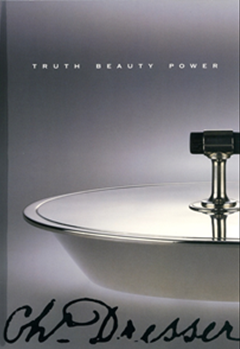 Dr. Christopher Dresser was born in Glasgow in 1834. He trained in design and studied Botany. After his appointment as Professor of Artistic Botany in the Department of Science and Art, South Kensington and soon sold his designs to British manufacturers. Dresser’s abilities became widely recognized and he was commissioned by Tiffany & Co. NY in 1877 to form an extensive collection of artistic Japanese goods. The exemplary works which he assembled for Tiffany’s inspired both Dresser and Tiffany’s designers. Dresser himself was influenced by the Japanese aesthetic and incorporated elements of Japanese designs into many of his ceramic designs for Minton’s, the Linthorpe Pottery and wares of Old Hall China. He has also become world reknowned for the elegant reductive Japanese-inspired metalwork designs in silver and silver-plate for the British firms Elkington & Co., James Dixon & Sons, Hukin and Heath and Heath and Middleton. These severely modern interpretations of Dresser have earned him the honorary title of the “Father of Modern Design”.
Dr. Christopher Dresser was born in Glasgow in 1834. He trained in design and studied Botany. After his appointment as Professor of Artistic Botany in the Department of Science and Art, South Kensington and soon sold his designs to British manufacturers. Dresser’s abilities became widely recognized and he was commissioned by Tiffany & Co. NY in 1877 to form an extensive collection of artistic Japanese goods. The exemplary works which he assembled for Tiffany’s inspired both Dresser and Tiffany’s designers. Dresser himself was influenced by the Japanese aesthetic and incorporated elements of Japanese designs into many of his ceramic designs for Minton’s, the Linthorpe Pottery and wares of Old Hall China. He has also become world reknowned for the elegant reductive Japanese-inspired metalwork designs in silver and silver-plate for the British firms Elkington & Co., James Dixon & Sons, Hukin and Heath and Heath and Middleton. These severely modern interpretations of Dresser have earned him the honorary title of the “Father of Modern Design”.
View Christopher Dresser works here.
ARCHIBALD KNOX (1864-1933)
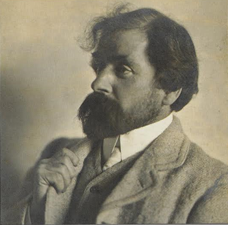 Archibald Knox was born on the Isle of Man and throughout his childhood he developed a fascination with Celtic ornament. He first expressed this artistic passion as a graphic artist, but in 1897 he was hired by Arthur Lasenby Liberty of Liberty & Company in London where he became the premier designer of Liberty’s Tudric (pewter) line and Cymric (silver) lines of ornamental and utilitarian objects. Knox left Liberty’s in 1912 and retired to teaching at the Douglas School of Art on his native Isle of Man until his death in 1933. Objects designed by Archibald Knox can now be found in private collections and museum collections all over the world.
Archibald Knox was born on the Isle of Man and throughout his childhood he developed a fascination with Celtic ornament. He first expressed this artistic passion as a graphic artist, but in 1897 he was hired by Arthur Lasenby Liberty of Liberty & Company in London where he became the premier designer of Liberty’s Tudric (pewter) line and Cymric (silver) lines of ornamental and utilitarian objects. Knox left Liberty’s in 1912 and retired to teaching at the Douglas School of Art on his native Isle of Man until his death in 1933. Objects designed by Archibald Knox can now be found in private collections and museum collections all over the world.
View Archibald Knox works here.
CARL VAN VECHTEN (1880 – 1964)
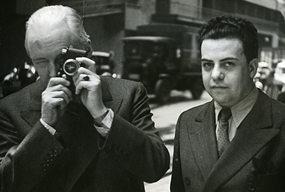 Carl van Vechten was a highly regarded American cultural impressario of the early 20th century, an influential writer and author who created some of the most salacious stories and novels of the Jazz Age. By the early 1930s, he began experimenting with portrait photography. Van Vechten was fascinated by American black culture and became one of the most important patrons and promoters of the Harlem Renaissance. He was at the center of it all and his photographic portraits of the leading literary artists of the period, as well as many stage and film actors, dancers and other performers and celebrities have become one of the most significant photographic portrait archives of the 20th Century. Amongst his close confidents were iconic figures such as Gertrude Stein, Langston Hughes, Alfred Knopf and George Gershwin. Large collections of van Vechten’s photographs can be found at the Beinecke Library at Yale University, Fisk University, the New York Public Library, the Carl Priebe Collection at Marquette University in Milwaukee, Brandeis University at Waltham,MA, the Library of Congress, the Prentiss Taylor collection in the Archives of American Art/ Smithsonian as well as the Museum of the City of New York.
Carl van Vechten was a highly regarded American cultural impressario of the early 20th century, an influential writer and author who created some of the most salacious stories and novels of the Jazz Age. By the early 1930s, he began experimenting with portrait photography. Van Vechten was fascinated by American black culture and became one of the most important patrons and promoters of the Harlem Renaissance. He was at the center of it all and his photographic portraits of the leading literary artists of the period, as well as many stage and film actors, dancers and other performers and celebrities have become one of the most significant photographic portrait archives of the 20th Century. Amongst his close confidents were iconic figures such as Gertrude Stein, Langston Hughes, Alfred Knopf and George Gershwin. Large collections of van Vechten’s photographs can be found at the Beinecke Library at Yale University, Fisk University, the New York Public Library, the Carl Priebe Collection at Marquette University in Milwaukee, Brandeis University at Waltham,MA, the Library of Congress, the Prentiss Taylor collection in the Archives of American Art/ Smithsonian as well as the Museum of the City of New York.
View Carl van Vechten works here.
TOMMI PARZINGER (1903-1981)
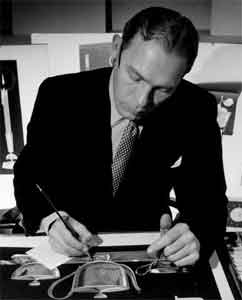 Tommi Parzinger was born in Munich and educated there in arts and design at the Kunstgewerbeschule. He established himself as a successful ceramic, textile and furniture designer before emigrating to New York in 1932. Parzinger became interested in designing accessories and began a collaboration with the silversmith and enamelist, Peter Riemes, who executed some of his designs in hand-wrought sterling silver. In a LIFE magazine article in 1939, it stated that Parzinger’s silver was unique in his “light, graceful feeling and fine etched decoration”. The article also recognized him at the time as the “most creative original designer of silverware in the United States.
Tommi Parzinger was born in Munich and educated there in arts and design at the Kunstgewerbeschule. He established himself as a successful ceramic, textile and furniture designer before emigrating to New York in 1932. Parzinger became interested in designing accessories and began a collaboration with the silversmith and enamelist, Peter Riemes, who executed some of his designs in hand-wrought sterling silver. In a LIFE magazine article in 1939, it stated that Parzinger’s silver was unique in his “light, graceful feeling and fine etched decoration”. The article also recognized him at the time as the “most creative original designer of silverware in the United States.
View Tommi Parzinger works here.
PETER CANTY (b. 1938)
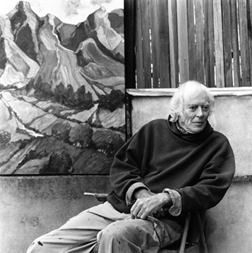 Berkeley artist Peter Canty received his BA in art from the Chouniard Art Institute, Los Angeles (now California Institute of the Arts) and an MA from the University of California, Santa Cruz in 1969. Heavily influenced by the Post-Impressionist masters Van Gogh, Gauguin, and Cezanne, in his own words Canty describes his interest in landscapes, believing they are “the best vehicle for motion, force, and color dynamics”. Although his work references realistic subjects, Canty’s imagery is drawn strictly from his own imagination. Drawn from his own mind the paintings also come to reality in his own “garden” studio. The spaciousness of being outdoors and Canty’s eye to the appeal of large paintings in the Contemporary market place has encouraged him to paint many of his canvases in a formidable scale often in the 3-5 foot range. The viewer of his lush canvases is offered the opportunity to fully engage in his most favored subject, the naturalism of the California. The compositions may include a Pacific coastal scene, Cypress groves, a rustic forest with vegetation or a vase of freshly cut indigenous flowers.
Berkeley artist Peter Canty received his BA in art from the Chouniard Art Institute, Los Angeles (now California Institute of the Arts) and an MA from the University of California, Santa Cruz in 1969. Heavily influenced by the Post-Impressionist masters Van Gogh, Gauguin, and Cezanne, in his own words Canty describes his interest in landscapes, believing they are “the best vehicle for motion, force, and color dynamics”. Although his work references realistic subjects, Canty’s imagery is drawn strictly from his own imagination. Drawn from his own mind the paintings also come to reality in his own “garden” studio. The spaciousness of being outdoors and Canty’s eye to the appeal of large paintings in the Contemporary market place has encouraged him to paint many of his canvases in a formidable scale often in the 3-5 foot range. The viewer of his lush canvases is offered the opportunity to fully engage in his most favored subject, the naturalism of the California. The compositions may include a Pacific coastal scene, Cypress groves, a rustic forest with vegetation or a vase of freshly cut indigenous flowers.
View Peter Canty paintings here.
TIM LIDDY (b. 1963)
 The idea of play has been a recurring theme in the work of artist Tim Liddy. Basing his circa series, primarily on the reproduction of vintage board game covers, Liddy sometimes plays with the boundaries of truth and fiction—never letting on which is real and which is not—in his own period assimilations. A keen observer will see decades of American culture unfold within these board games: social norms and paradigms, gender and racial stereotypes, class separation, and occupational procurement, among other underlying themes. By Liddy re-contextualizing the subject, viewers get a glimpse of our shared past, perhaps experiencing fond nostalgia or utter embarrassment. Tim Liddy’s painted constructions so closely resemble their board game inspirations that many viewers walk right past, thinking they must be found objects. Liddy relishes the confusion. The works are actually elaborately enameled copper sculptures, each seemingly printed word and every abraded strip of masking tape made by the artist. Once you’ve discovered the truth, you are caught up in the astonishing detail and verisimilitude, and you’re drawn in to investigate more closely. Within the recognizable format of a mid-twentieth-century game box are surprising elements that are often at odds with the traditional object. Liddy inserts wry commentary on mid-century social mores into this comfortably recognizable context. The fact that the boxes seem to be held together tenuously by tape suggests the rapidly eroding conventions of an earlier era.
The idea of play has been a recurring theme in the work of artist Tim Liddy. Basing his circa series, primarily on the reproduction of vintage board game covers, Liddy sometimes plays with the boundaries of truth and fiction—never letting on which is real and which is not—in his own period assimilations. A keen observer will see decades of American culture unfold within these board games: social norms and paradigms, gender and racial stereotypes, class separation, and occupational procurement, among other underlying themes. By Liddy re-contextualizing the subject, viewers get a glimpse of our shared past, perhaps experiencing fond nostalgia or utter embarrassment. Tim Liddy’s painted constructions so closely resemble their board game inspirations that many viewers walk right past, thinking they must be found objects. Liddy relishes the confusion. The works are actually elaborately enameled copper sculptures, each seemingly printed word and every abraded strip of masking tape made by the artist. Once you’ve discovered the truth, you are caught up in the astonishing detail and verisimilitude, and you’re drawn in to investigate more closely. Within the recognizable format of a mid-twentieth-century game box are surprising elements that are often at odds with the traditional object. Liddy inserts wry commentary on mid-century social mores into this comfortably recognizable context. The fact that the boxes seem to be held together tenuously by tape suggests the rapidly eroding conventions of an earlier era.
View Tim Liddy paintings here.
STEPHEN MCSWAIN (b. 1969)
 Guitars, guitars, guitars – electric guitars are everywhere. They have been around for something like 50 years and haven’t changed much since their inception. Tired of seeing the same old guitars and designs, artist, luthier, and musician Stephen McSwain decided to create a new breed he likes to call “functional art.” Each instrument is hand made, one at a time, and has unique characteristics that make it a highly collectible guitar or piece of art, depending on how you look at it. It all began many years ago with a motor carving tool, some Exacto knives, artistic and musical aptitude passed along and nurtured by Mom and Dad McSwain, and a whole lot of patience and persistence. The first guitar body was purchased from a guitar parts supply company as a completely experimental piece. Stephen started carving faces into the wood and eventually ended up with the guitar that is now in the possession of Steve Vai. That was number 0001. It all takes place in McSwain’s laboratory (basically a converted garage) in the heart of Los Angeles. The wood is chosen for each custom made guitar to go under the knife, metal is polished, scorched, etched and riveted and the gauges are rescued from abandoned scrap heaps, all in the alchemy of building a better beast, a rockin’ McSwain electric guitar!
Guitars, guitars, guitars – electric guitars are everywhere. They have been around for something like 50 years and haven’t changed much since their inception. Tired of seeing the same old guitars and designs, artist, luthier, and musician Stephen McSwain decided to create a new breed he likes to call “functional art.” Each instrument is hand made, one at a time, and has unique characteristics that make it a highly collectible guitar or piece of art, depending on how you look at it. It all began many years ago with a motor carving tool, some Exacto knives, artistic and musical aptitude passed along and nurtured by Mom and Dad McSwain, and a whole lot of patience and persistence. The first guitar body was purchased from a guitar parts supply company as a completely experimental piece. Stephen started carving faces into the wood and eventually ended up with the guitar that is now in the possession of Steve Vai. That was number 0001. It all takes place in McSwain’s laboratory (basically a converted garage) in the heart of Los Angeles. The wood is chosen for each custom made guitar to go under the knife, metal is polished, scorched, etched and riveted and the gauges are rescued from abandoned scrap heaps, all in the alchemy of building a better beast, a rockin’ McSwain electric guitar!
